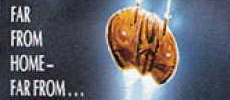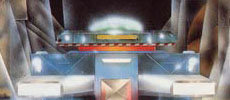SonikMatter Interview (part 3)
by Rick 'Brujo' Wishart with assistance from Brian 'Cowzar' Cowell
11. Do you believe that the traditional hardware synth companies will survive in the longer term with their present business model ? How may they adapt ?
There will always be a case for hardware synths, particularly for live use, since their polyphony and performance is guaranteed, with no glitches, clicks, or pops. Moreover, although most musicians are perfectly happy working with a computer front end, it's sometimes very satisfying to switch on a synth and just play, without having to think about memory, latency, and multi-tasking operating systems.
On the other hand, products like Spectrasonics' Atmosphere and Trilogy have proved to hardware manufacturers that if treated seriously, the softsynth can produce a range of sounds that go beyond the capabilities of most hardware boxes. Judging by the popularity yet cost-effectiveness of such products, I expect we will eventually see some from the 'big name' synth manufacturers, once they are convinced that it's profitable.
However, most hardware manufacturers are already dipping their corporate toes in the software waters, but they are understandably wary of piracy. A half-way house is to design software front-ends for existing hardware synths, to make them more accessible in a computer environment. I hope Yamaha's OPT (Open Plugin Technology) will eventually get much wider support in this area, since this open standard provides the glue between existing MIDI+Audio applications and external synth hardware, without getting involved with running multiple applications and working round the limitations of multi-tasking drivers. What we need is less barriers between hardware and software, so you can use them together more easily.
12. What would be the most humorous thing you've seen/heard happen in the music industry?
Having done it myself in the past, I'm always sympathetic to people demonstrating products at music shows, since things can (and often do) go wrong. I've witnessed my fair share of embarrassing moments, particularly when computers crash, and you can see the beads of sweat start to run down people's faces, although some masterful demonstrators can even turn this into a feature, by claiming that this is the first time the software's crashed in a week, which is amazingly reliable for a Beta version.
The most embarrassing demos are those with a dummy prototype out front (the product, not the demonstrator), while the real product, still in a vast casing with wires hanging out, and surrounded by a team of boffins, is being manipulated behind the scenes, since when something goes wrong the front man is completely floundering.
Shows and the unexpected go hand in hand. Once, in my early days working for Atari, I left their stand for a few minutes to visit the toilet, and when I came back I'd been volunteered to be interviewed live on radio thirty minutes later by 'Whispering' Bob Harris, who used to present the BBC's famous Old Grey Whistle Test music programme. Thankfully, he was quite charming, and I acquitted myself reasonably well.
Sometimes marketing claims get a little out of hand, and it's surprising how many people take them at face value without checking. Some years ago I reviewed a soundcard whose software claimed to play back up to 128 tracks mixed down to stereo using a unique 'rendering' algorithm similar to those used in 3D graphics programs, which made it possible to extract the constituent tracks at any time, despite only storing the final stereo mix on your hard drive. The UK distributors were really excited by this, but it only took me about half an hour of testing to disprove these claims, and by the time my review came out the retail price had dropped by 50%.
13. Can you outline the process in designing, programming and publishing a computer game ?
I'm sure the process is far more organised and streamlined than when I used to write them back in the 80's, but I can only comment on how I did it. My Commodore 64 games all started with an idea that was a twist on something that already existed.
For instance, 'Hunter's Moon' was a combination of a shoot 'em up and Spirograph - that children's game with the multiple wheels that you rolled around with a pen to create complex multi-coloured geometric drawings. This sparked off the idea of the worker cells that moved in similar ways, dropping bricks to create 2-dimensional cities in space. When you first entered a game level the city might be complete or partially constructed, but it was growing or regrowing the whole time you tried to find and capture the starcells to get to the next level.
'Citadel' was a combination of a shoot 'em up and a board game, where your opponents only saw you as a threat when you moved from one 'square' to another. So, you could either play it by racing around blasting everything in sight, or by stopping and carefully considering each move and its outcome before taking your next step.
Normally I approached a software publisher once I had one or two basic playable levels programmed, to sell the idea and get a contract and advance to keep me going until the game was completed and royalties hopefully starting rolling in. However, I was still essentially free to let my ideas develop at their own pace, and of course being the creator, programmer, graphic designer, and composer, I could just run with whatever ideas occurred during this process, with a visit from the software house every few weeks to see how everything was progressing.
14. What type of routines are used to simulate AI in computer games ?
Very primitive ones in the case of most CBM64 games, since we only had 64 kilobytes of RAM to programme the entire thing. However, it was still possible to implement what seemed like intelligence, by programming a table of likely movement behaviour for the 'baddies' based on their relative position to you. Once you added a few random numbers to weight a few such strategies, your opponents could seem surprisingly intelligent!
Nowadays I suspect far more complex strategies are adopted, since so much more memory is available, but by giving each opponent a fixed route to patrol, or one of several randomly chosen ones, plus a few extra ploys chosen at random once you're within a certain proximity, it must still be surprisingly effective at giving the impression of intelligence.
15. In writing music for video games, how do you decide on what's the best style of music? What strengths/weaknesses did you encounter with the various platforms on which you programmed the music?
In my experience you rarely had the opportunity to choose the style of music, since the software house that approached you nearly always had their own strong ideas on subject matter. If you were composing the soundtrack for an original game then you might get lucky enough to meet the programmer(s) and discuss it creatively with them, but most were happy to have the publishing company liaise, and in this case you could expect a request for some 'Terminator-style' music with alarming regularity, since so many games were set in the future.
Games set in a particular historical context were more interesting, and I did get to write some gungho orchestral music for 2nd World War games, medieval ensembles, military marching music for the American Civil War, as well as the odd string quartet or thrash metal track. However, often the most creative opportunities came with 'cartoon-style' games where you could really let your imagination run riot. I once wrote music for a game that took place in a kitchen freezer, where the instruments consisted of the sounds of food being eaten and drinks being opened and consumed, while on the next level, which took place in a roadworks, I used pneumatic drills, singing saws, hammers, and so on. That was fun.
Sometimes the most challenging commissions were conversions of tunes that had originally been written to suit other game formats, and I had an excellent reputation for squeezing the last drop out of conversions from multi-track orchestral sampled compositions that ended up transcribed for three channels of beeps on the Nintendo Gameboy!

